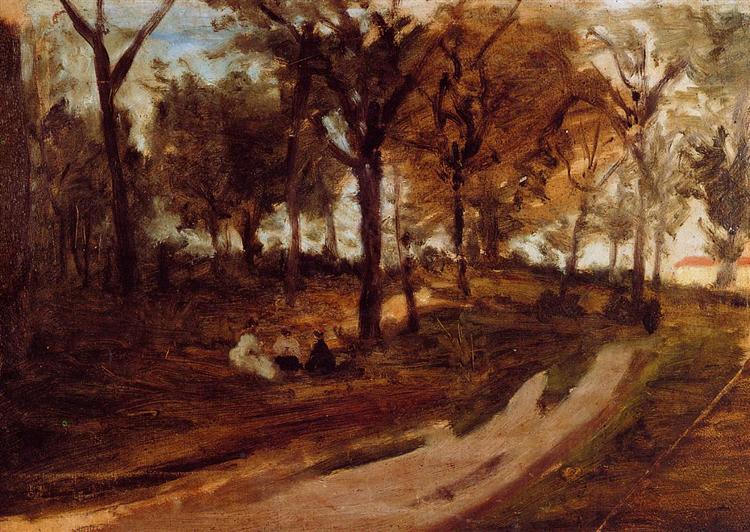Descrizione
Il dipinto "nella foresta di santi" di Paul Gauguin, realizzato nel 1873, incapsula la ricerca della sensazione della natura vergine e del simbolismo che avrebbe inondato il suo lavoro successivo. Sebbene questo lavoro possa essere considerato un precursore dello stile più audace ed espressivo che lo caratterirebbe durante il suo periodo a Tahití, puoi già apprezzare alcuni degli elementi che definirebbero la sua evoluzione come artista. Mentre osserviamo questo lavoro, siamo immersi in un ambiente naturale che non è solo uno sfondo, ma un potente protagonista che intreccia la connessione tra l'essere umano e la natura.
Gauguin usa una tavolozza di colori ricca e vibrante che ruota attorno a toni di ombre verdi e profonde intense, evocando un senso quasi onirico dell'ambiente. Questi verdi, integrati con lampi di luce che abbagliano in giallo e bianco, contrastano significativamente con le figure umane che, sebbene presenti, sembrano essere secondarie nella propria esistenza all'interno del paesaggio. La composizione è articolata in un modo che suggerisce profondità, invitando lo spettatore a perdersi nella foresta ed esplora il suo significato.
I personaggi, sebbene in posizione marginale, sono essenziali per l'interpretazione del lavoro. Puoi vedere figure femminili rappresentate con forme morbide e stilizzate, integrando armoniosamente nel loro ambiente naturale. Sembrano fluire con il paesaggio, infondono il lavoro una qualità quasi mitica, come se avessero incarnato l'essenza stessa della natura che li circonda. Questa interrelazione tra la figura umana e l'ambiente illustra l'interesse di Gauguin per le connessioni più profonde tra l'essere umano e il suo ambiente naturale, un tema ricorrente che ha esplorato durante la sua carriera.
"In The Saint Cloud Forest" offre anche un'impronta della tecnica di Gauguin, che in questa fase ha sperimentato un'applicazione più libera e meno dettagliata del dipinto rispetto ai suoi contemporanei. Le pennellate sono sciolte e veloci, suggerendo un movimento continuo e un'immediatezza che cattura la transitorie di un istante. Questo approccio impressionista, che in questo lavoro si manifesta in un'atmosfera di mutevole luce e sfumature spontanee, contrasta con la sua inclinazione futura alla semplificazione e alla stilizzazione delle forme che segnerebbero il suo periodo simbolico.
È affascinante considerare che "nella foresta di santo" è stata effettuata in un momento in cui Gauguin ha iniziato a prendere le distanze dalle convenzioni accademiche che hanno predominato nel suo tempo. Questo lavoro è intriso di un senso di libertà, una sorta di prospettiva in cui la natura non è solo uno sfondo passivo, ma un elemento dinamico che viene intrecciato con l'esistenza umana. È un riflesso del suo desiderio di esplorare questioni di spiritualità e natura, un preambolo delle sue successive esplorazioni in Polinesia.
Nel contesto più ampio del movimento post -impressionista, questo dipinto può essere visto come un ponte verso le esplorazioni più profonde e filosofiche che Gauguin farebbe nelle sue opere future. "Nella foresta cloud di Saint" non è quindi solo una testimonianza della bellezza del paesaggio francese, ma una finestra per la mente di un artista in evoluzione che ha iniziato a sfidare le nozioni estetiche del suo tempo e a cercare il proprio linguaggio visivo . È un promemoria di come la natura, nella sua essenza più purista, possa essere sia un rifugio che una fonte infinita di ispirazione.
KUADROS ©, una famosa vernice sul muro.
Dipinti ad olio fatti a mano, con la qualità degli artisti professionisti e il distintivo sigillo di KUADROS ©.
Servizio di riproduzione delle immagini con garanzia di soddisfazione. Se non sei completamente soddisfatto della replica del tuo dipinto, rimborsiamo i tuoi soldi al 100%.

